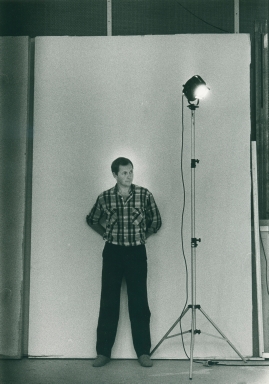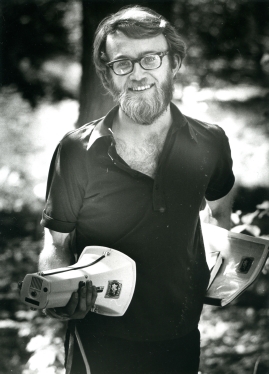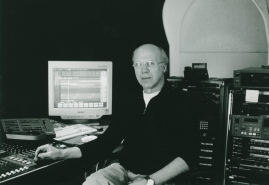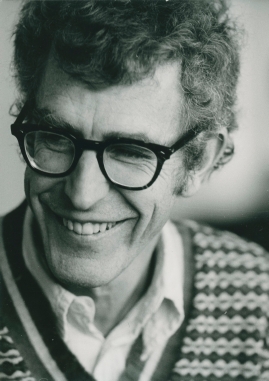Roy Andersson
Table of contents
- Basic facts
- Links and resources
- Biography
- Awards
- Films
- Original work
- Soundtrack listing
- Groups
Basic facts
Media (2)
| Director | |
|---|---|
| Screenplay | |
| Show all films | |
| Awards |
|
Biography
Roy Andersson was born in Gothenburg, Sweden, in 1943. His first feature A Swedish Love Story (1970) won the main prize at the Berlinale IFF 1970. Giliap (1975), his second film, was presented at the Directors' Fortnight in Cannes 1976. In 1975 he started making unusual and very successful commercials, which won a total of eight Golden Lions at Cannes. In 1981 he founded Studio 24 in order to produce and make his films in total freedom. After Something Happened (1987) and World of Glory (1991), two shorts that returned with the most prestigious...
Links and resources
Biography
Roy Andersson was born in Gothenburg, Sweden, in 1943. His first feature A Swedish Love Story (1970) won the main prize at the Berlinale IFF 1970. Giliap (1975), his second film, was presented at the Directors' Fortnight in Cannes 1976. In 1975 he started making unusual and very successful commercials, which won a total of eight Golden Lions at Cannes. In 1981 he founded Studio 24 in order to produce and make his films in total freedom. After Something Happened (1987) and World of Glory (1991), two shorts that returned with the most prestigious awards (a.o. Clermont-Ferrand), he shot Songs from the Second Floor in his studio (March 1996-May 2000) and won the Special Jury Prize in Cannes 2000. You, the Living (2007) won several international awards as well as the Guldbagge Award for Best Director, Best Screenplay and Best Picture. A Pigeon Sat on a Branch Reflecting on Existence (2014), his fifth feature film, was awarded the Golden Lion in Venice.
-
Roy Andersson's development as a film director is marked by contrasts. A lyrical feeling for everyday Swedish life earned him his breakthrough, whereupon he bowed out of feature filmmaking for some years, returning triumphantly with highly stylised films presenting absurd tableaux in highly personal settings shot entirely in the studio.
People in Sweden could follow his journey from one pole to the other via the many distinctive commercials which emerged and continue to emerge from Andersson's studio.
By the time he entered the Swedish Film Institute Film School in 1967, Roy Andersson had already studied literature and philosophy at university. In 1968 he was an assistant director on the shoot of Bo Widerberg's The Adalen Riots (Ådalen 31, 1969), and in 1970 he made his own directorial debut with En kärlekshistoria ('A Love Story').
This film about the love story of a teenage couple - the first Swedish film to feature stereo sound - was a hit both at the box office and with the critics. Yet Andersson felt himself weighed down by his success, which he has later given as a reason as to why his next film, Giliap (1975), has a different and much bleaker tone. Making the film was a long, drawn-out process. Despite being championed by certain commentators, including the Swedish writer and Swedish Academy member Lars Forssell, the film met with a negative reception and was a financial failure.
It took 25 years before Roy Andersson returned with a vengeance to feature filmmaking with his Songs from the Second Floor (Sånger från andra våningen, 2000), which won him the Cannes Jury Prize and Swedish Guldbagge awards for best director and best screenplay. Andersson followed this up and scooped the same Gulbagge awards for You, the Living (Du levande, 2007). A Pigeon Sat on a Branch Contemplating Existence (En duva satt på en gren och funderade på tillvaron) premiered in autumn 2014. Andersson has referred to these films as his "You, the Living trilogy".
The Roy Andersson who returned with Songs… was in a different position from the young man of the 1970s. A successful career as a director of commercials had enabled him to set up his own company, Studio 24, in the inner city of Stockholm. His own modest production facilities, his long-term colleagues and his studio have given Roy Andersson, in his more recent filmmaking career, major opportunities to work at his own pace and in his own way.
The Czech directors Jirí Menzel and Milos Forman have been significant influences on Roy Andersson. It is especially apparent in A Love Story just how much Andersson learnt from them about the absurd and comical elements of simple everyday situations. Polish director Andrzej Wajda's Ashes and Diamonds (1958), on the other hand, provided much of the inspiration for Giliap.
Over the course of hundreds of commercials Roy Andersson has honed his ability to find gold amid the greyness of everyday Swedish life. A series of commercials for the insurance giant Trygg-Hansa laid the foundations of his reputation, followed by films for companies such as Estrella and Lotto. Almost all of them are shot in one take, and as in the later feature films, all the participants are basically amateurs, often selected on the basis of being interesting characters. Lars Nordh (1936-2011), who appeared in so many films, was discovered at an Ikea store, for example. Roy Andersson often refers to his cast members as "characters", part of his tableau as a whole, thus reducing the emphasis on any conventional demand for acting.
Andersson's determination to make films as he sees fit led to some highly publicised problems in 1987 when he produced a film about AIDS, commissioned by the National Swedish Board of Health and Welfare, in which he included some rather unorthodox theories as to the origins of the disease.
Like his commercials, the feature films are basically made entirely in his own Stockholm studios. In part Andersson has withdrawn indoors in order to control every aspect of each image. The feel this produces is artificial. The dialogue tends to be full of everyday phrases, which assume an absurd resonance when Andersson's awkward cast members repeat them over and over again. The theme is often our inadequate ability to make contact, in the worst cases manifested as a refusal even to acknowledge the other person as a human being. There are references to the horrors of war and colonialism in the films as well as in the two books he has produced, "Lyckad nedfrysning av herr Moro" ('Mr. Moro Being Successfully Frozen,' 1992) and "Vår tids rädsla för allvar" ('Our Times' Fear of Seriousness,' 1995).
That Roy Andersson is entirely his own man is also apparent from his often highly personal choice of film titles. Songs from the Second Floor derives from the fact that that the screenplay was written on the second floor of the Studio 24 premises. And according to Andersson, A Pigeon Sat on a Branch Contemplating Existence got its name when, wrestling with the script for the film, he saw a pigeon outside his window and toyed with the idea that it had similar concerns to his own. Later he went on to cite Pieter Breughel the Elder's painting "Hunters in the Snow" as his inspiration both for the title and the film. You, the Living is a quotation from Goethe cited in the film.
Mårten Blomkvist (2014)
Translated by Derek Jones
Awards
| Nominated for the Guldbagge Award | Stockholm | 2020 | Best Director | ||
|---|---|---|---|---|---|
| Stockholm | 2020 | Best Screenplay | |||
| Leone d'Argento di San Marco (Silver Lion) | Venice | 2019 | (bästa regi, Best Direction, Mostra Internazionale d'Arte Cinematografica della Biennale di Venezia, Italien) | ||
| Nominated for the Guldbagge Award | Stockholm | 2015 | Best Director | ||
| Festival Award | Fantasporto | 2008 | (pris till bästa regissör/best director award vid filmfestivalen i Fantasporto, Portugal) | ||
| The Guldbagge Award | Stockholm | 2008 | Best Screenplay | ||
| Prize | Helsinki | 2008 | Nordiska Rådets filmpris. | ||
| The Guldbagge Award | Stockholm | 2008 | Best Director | ||
| Silver Hugo | Chicago | 2007 | (Silver Hugo for Direction, Chicago International Film Festival, USA) | ||
| The Guldbagge Award | Stockholm | 2001 | Best Screenplay | ||
| Stockholm | 2001 | Best Director | |||
| Prize | Älvkarleby | 2000 | (Stig Dagerman-pris) | ||
| Gothenburg | 2000 | (hedersdoktor vid universitet i Göteborg) | |||
| The Kurt Linder Grant | Stockholm | 1970 | |||
| Chaplin Magazine Award | Stockholm | 1970 |





